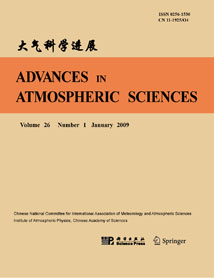| [1] |
Xin QUAN, Xiaofan LI,
2023: Kinetic Energy Budgets during the Rapid Intensification of Typhoon Rammasun (2014), ADVANCES IN ATMOSPHERIC SCIENCES, 40, 78-94.
doi: 10.1007/s00376-022-2060-z
|
| [2] |
Xiuping YAO, Ruoying LI, Xiaohong BAO, Qiaohua LIU,
2024: Diagnosis of the Kinetic Energy of the “21·7” Extreme Torrential Rainfall Event in Henan Province, China, ADVANCES IN ATMOSPHERIC SCIENCES, 41, 73-83.
doi: 10.1007/s00376-023-3025-6
|
| [3] |
ZUO Qunjie, GAO Shouting, and LÜ Daren,
2014: Eddy Kinetic Energy Study of the Snowstorm over Southern China in January 2008, ADVANCES IN ATMOSPHERIC SCIENCES, 31, 972-984.
doi: 10.1007/s00376-013-3122-z
|
| [4] |
Minwei Qian, N. Loglisci, C. Cassardo, A. Longhetto, C. Giraud,
2001: Energy and Water Balance at Soil-Air Interface in a Sahelian Region, ADVANCES IN ATMOSPHERIC SCIENCES, 18, 897-909.
|
| [5] |
WANG Linlin, GAO Zhiqiu, MIAO Shiguang, GUO Xiaofeng, SUN Ting, Maofeng LIU, Dan LI,
2015: Contrasting Characteristics of the Surface Energy Balance between the Urban and Rural Areas of Beijing, ADVANCES IN ATMOSPHERIC SCIENCES, 32, 505-514.
doi: 10.1007/s00376-014-3222-4
|
| [6] |
SUN Shufen, ZHANG Xia,
2004: Effect of the Lower Boundary Position of the Fourier Equation on the Soil Energy Balance, ADVANCES IN ATMOSPHERIC SCIENCES, 21, 868-878.
doi: 10.1007/BF02915589
|
| [7] |
WANG Runyuan, ZHANG Qiang,
2011: An Assessment of Storage Terms in the Surface Energy Balance of a Subalpine Meadow in Northwest China, ADVANCES IN ATMOSPHERIC SCIENCES, 28, 691-698.
doi: 10.1007/s00376-010-9152-x
|
| [8] |
Qiu Yongyan,
1993: On the Seasonal Transition and the Interannual Variability in Global Kinetic Energy at 500 hPa, Accompanied with Anomalies of Energy during the 1982 / 83 ENSO, ADVANCES IN ATMOSPHERIC SCIENCES, 10, 248-256.
doi: 10.1007/BF02919148
|
| [9] |
ZUO Qunjie, GAO Shouting, LU Daren,
2012: Kinetic and Available Potential Energy Transport during the Stratospheric Sudden Warming in January 2009, ADVANCES IN ATMOSPHERIC SCIENCES, 29, 1343-1359.
doi: 10.1007/s00376-012-1198-5
|
| [10] |
YUE Ping, ZHANG Qiang, WANG Runyuan, LI Yaohui, WANG Sheng,
2015: Turbulence Intensity and Turbulent Kinetic Energy Parameters over a Heterogeneous Terrain of Loess Plateau, ADVANCES IN ATMOSPHERIC SCIENCES, 32, 1291-1302.
doi: 10.1007/s00376-015-4258-9
|
| [11] |
Wang Zuoshu, Zhang Ruojun, Peng Zhengyi,
1989: The Kinetic Energy Budget and Circulation Characteristics of the Tropical Storm Irma during AMEX Phase II, ADVANCES IN ATMOSPHERIC SCIENCES, 6, 414-423.
doi: 10.1007/BF02659076
|
| [12] |
D.R. Chakraborty, N.K. Agarwal,
1996: Role of Triad Kinetic Energy Interactions for Maintenance of Upper Tropospheric Low Frequency Waves during Summer Monsoon 1988, ADVANCES IN ATMOSPHERIC SCIENCES, 13, 91-102.
doi: 10.1007/BF02657030
|
| [13] |
ZHU Zhilin, SUN Xiaomin, ZHANG Renhua,
2003: Statistical Analysis and Comparative Study of Energy Balance Components Estimated Using Micrometeorological Techniques during HUBEX/IOP 1998/99, ADVANCES IN ATMOSPHERIC SCIENCES, 20, 285-291.
doi: 10.1007/s00376-003-0014-7
|
| [14] |
Lei WANG, Qing BAO, Wei-Chyung WANG, Yimin LIU, Guo-Xiong WU, Linjiong ZHOU, Jiandong LI, Hua GONG, Guokui NIAN, Jinxiao LI, Xiaocong WANG, Bian HE,
2019: LASG Global AGCM with a Two-moment Cloud Microphysics Scheme: Energy Balance and Cloud Radiative Forcing Characteristics, ADVANCES IN ATMOSPHERIC SCIENCES, , 697-710.
doi: 10.1007/s00376-019-8196-9
|
| [15] |
Chen Yingyi, Chao Jiping,
1984: A TWO-DIMENSIONAL ENERGY BALANCE CLIMATE MODEL INCLUDING RADIATION AND ICE CAPS-ALBEDO FEEDBACK, ADVANCES IN ATMOSPHERIC SCIENCES, 1, 234-255.
doi: 10.1007/BF02678136
|
| [16] |
He Jinhai, T. Murakami, T. Nakazawa,
1987: ENERGY BALANCE IN 40-50 DAY PERIODIC OSCILLATION OVER THE ASIAN SUMMER MONSOON REGION DURING THE 1979 SUMMER, ADVANCES IN ATMOSPHERIC SCIENCES, 4, 66-73.
doi: 10.1007/BF02656662
|
| [17] |
LI Yuefeng,
2007: Conversion of Kinetic Energy from Synoptic Scale Disturbance to Low-Frequency Fluctuation over the Yangtze River Valley in the Summers of 1997 and 1999, ADVANCES IN ATMOSPHERIC SCIENCES, 24, 591-598.
doi: 10.1007/s00376-007-0591-y
|
| [18] |
Lu Yurong, Gao Guodong,
1984: A STUDY OF WATER BALANCE IN CHINA, ADVANCES IN ATMOSPHERIC SCIENCES, 1, 165-187.
doi: 10.1007/BF02678129
|
| [19] |
FENG Juan*, CHEN Wen,
2014: Interference of the East Asian Winter Monsoon in the Impact of ENSO on the East Asian Summer Monsoon in Decaying Phases, ADVANCES IN ATMOSPHERIC SCIENCES, 31, 344-354.
doi: 10.1007/s00376-013-3118-8
|
| [20] |
Gang LI, Daoyong YANG, Xiaohua JIANG, Jing PAN, Yanke TAN,
2017: Diagnosis of Moist Vorticity and Moist Divergence for a Heavy Precipitation Event in Southwestern China, ADVANCES IN ATMOSPHERIC SCIENCES, 34, 88-100.
doi: 10.1007/s00376-016-6124-9
|















 AAS Website
AAS Website 
 AAS WeChat
AAS WeChat 
 DownLoad:
DownLoad: